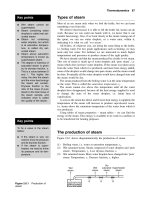Mechanical Engineering Systems 2008 Part 13 pps

Mechanical Engineering Systems 2008 Part 13 pps
... 7.07 m/s, 31.83 m/s 11. 134 .7 kPa 12. 7.62 × 10 –6 m 3 /s 13. 208 mm 14. 0.015 × 10 –6 m 3 /s 15. 2.64 m, 25.85 kPa 16. 21.3 m 17. 12.34 m 18. 57.7 kPa 19. 0 .13 m 3 /s 20. 0 .138 kg/s 21. 0.0762 m 3 /s 22. ... 184–6 Mass moment of inertia 188 Mechanical efficiency 191, 192 Mechanical work 190 Mechanics 204 Members: composite bars 241 compound 238 Metacentre 133 Metacentric height...
Ngày tải lên: 11/08/2014, 15:20

Mechanical Engineering Systems 2008 Part 5 pps
... leaving the evaporator is wet. h 1 = h f + x.h fg = 107.9 + (0.95 × 131 7.4) = 135 9.43 kJ Cooling load = ˙ m(h 1 – h 4 )= 4 60 (135 9.43 – 303.7) = 70.38 kW (b) The specific volume of the refrigerant ... h 4 = 1405.6 – 275.1 = 1130 .5 kJ/kg (a) COP = h 1 – h 4 h 2 – h 1 = 1130 .5 1694 – 1405.6 = 3.92 (b) Example 2.7.3 An ammonia refrigerating plant produces a cooling load of 13. 3 kW. T...
Ngày tải lên: 11/08/2014, 15:20

Mechanical Engineering Systems 2008 Part 1 pdf
... 2256.7 = 9026.8 kJ Total heat energy = Q 1 + Q 2 + Q 3 + Q 4 = 81.6 + 134 0 + 1680 + 9026.8 = 12 128.4 kJ. Mechanical Engineering Systems Thermodynamics 11 Example 2.1.4 A gas with a specific heat ... split this distance into ten million subdivisions called measures. In French this is Mechanical Engineering Systems Richard Gentle Peter Edwards Bill Bolton OXFORD AUCKLAND BOSTON J...
Ngày tải lên: 11/08/2014, 15:20

Mechanical Engineering Systems 2008 Part 3 pptx
... operating on the ideal dual combustion cycle the compression ratio is 13. 5:1. The maximum cycle pressure and temperature are 44 bar and 135 0°C respec- tively. If the initial pressure and temperature ... c p (T 1 – T 2 )=–43 750 (from ␦h = m.c p ␦T) 1005(170 – T 2 )=–43 750, T 2 = 213. 5°C T 2 T 1 = p 2 p 1 ␥–1 ␥ , 213. 5 + 273 170 + 273 = p 2 2 1.4–1 1.4 , 486.5 443 = p 2 2 ...
Ngày tải lên: 11/08/2014, 15:20

Mechanical Engineering Systems 2008 Part 4 potx
... therefore superheated. V 1 = 0.394 m 3 /kg p 1 V n 1 = p 2 V n 2 6 × 0.394 1 .13 = 1.5 × V 1 .13 2 , V 2 = 1 .13 ͱ සසසසස 6 × 0.394 1 .13 1.5 = 1.344 m 3 (a) Examination of the steam tables at 1.5 bar shows ... by, V = x.V g = 0.9 × 0.1408 = 0.127 m 3 /kg Thermodynamics 85 8 × 0.2 613 1.25 =4 × V 1.25 2 V 2 = 1.2 5 ͱ සසසසස 8 × 0.2 613 1.25 4 = 0.455 m 3 /kg V = x.V g at 4 bar 0.455 = x ×...
Ngày tải lên: 11/08/2014, 15:20

Mechanical Engineering Systems 2008 Part 6 pdf
... exposure record of what the particle does. In streamlined flow we would see that the particle followed exactly the line of flow of the liquid, as in this illustration of a particle flowing along in ... the individual particles stream along it. Turbulent flow is when the individual particles do not follow any regular path but their overall motion gives rise to the liquid flow. The particles ar...
Ngày tải lên: 11/08/2014, 15:20

Mechanical Engineering Systems 2008 Part 7 pptx
... laminar flow is necessary. One example from mainstream mechanical engineering is the dashpot. This is a device which is used to damp out any mechanical vibration or to cushion an impact. A piston ... level Fluid mechanics 145 Examples of laminar flow in engineering We have already touched on one example of laminar flow in pipes which is highly relevant to engineering but it is worth...
Ngày tải lên: 11/08/2014, 15:20

Mechanical Engineering Systems 2008 Part 8 docx
... in engineering terms that is only half the story. Forces in engineering dynamics are generally used to move something from one place to another or to alter the speed of a piece of machinery, particularly ... calculations is to introduce the idea of mechanical efficiency to represent how close a piece of mechanical equipment is to being ideal in energy terms. Mechanical efficiency =...
Ngày tải lên: 11/08/2014, 15:20

Mechanical Engineering Systems 2008 Part 10 doc
... a sketch of the body, divide it into a number of composite parts. A hole, i.e. a part having no material, can be considered to be a part having a negative weight or area. (2) Establish the co-ordinate ... with one part of it having a diameter of 60 mm and the other part a diameter of 30 mm (Figure 5.3.9) and is subject to an axial force of 20 kN. What will be the stresses in the two p...
Ngày tải lên: 11/08/2014, 15:20

Mechanical Engineering Systems 2008 Part 11 pptx
... central load F (Figure 5.4 .13) , the reactions at each end will be F/2. Figure 5.4.10 Example 5.4.1 Figure 5.4.11 Example 5.4.2 Figure 5.4.12 Example 5.4.2 Figure 5.4 .13 (a) Simply supported beam ... steel is 200 GPa and that of the copper 120 GPa. Figure 5.3.18 Problem 9 Figure 5.3.19 Problem 13 Statics 245 extension x, as in Figure 5.3.16, the average force applied is 1 2 F and so the...
Ngày tải lên: 11/08/2014, 15:20
- mechanical engineering technology curriculum
- cornerstone mechanical engineering subject
- handbook of mechanical engineering
- instructions for mechanical engineering exam
- andbook of mechanical engineering
- tips mechanical engineering curriculum
- c sharp part 13
- toefl cbt book part 13
- teaching academic esl writing part 13